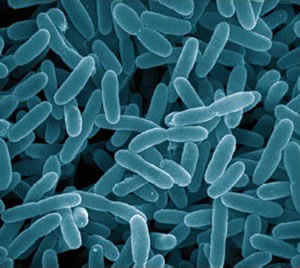Iron Bacteria
Does your water have a foul smell? Does it leave stains?
Iron Bacteria in well water is a common problem in Illinois. But it is often overlooked. Or worse, its confused for something else. Improper treatment can make this problem even worse.

What is Iron Bacteria?
Iron Bacteria are small living organisms which naturally occur in soil and water.
These nuisance bacteria combine iron and manganese with oxygen to form deposits of “rust”, and a slimy build up.
The most common bacteria known to feed on iron are Thiobacillus ferrooxidans and Leptospirillum ferrooxidans.
Iron Bacteria are not listed by the US Environmental Protection Agency (EPA) as either a primary or secondary contaminant. That’s because they are not known to cause disease.
They do cause stains. Horrible tastes and odors. And they can create conditions where other undesirable organisms may grow.
Iron Bacteria-Related Problems
There are two main clues that could indicate the presence of iron bacteria in your well water. Most common is a foul smell. Slimy buildup is another strong indicator.
Foul Taste and Odor
Iron Bacteria can produce a variety of unpleasant tastes and odors. This can sometimes cause it to be confused for different contaminants like Hydrogen Sulfide gas.
Common Iron Bacteria odors include:
- Swampy
- Rotten egg
- Sewage
- Fuel Oil
- Cucumber
The odor from Iron Bacteria may be worse if water hasn’t been used for a while. For example, the smell could be worse after you return from vacation.
You may also notice that the smell is worse in certain plumbing fixtures or bathrooms that are used less often.
Rust Stains and Slime
Iron, itself, will cause stains. Iron Bacteria will usually cause yellow, orange, red, or brown stains and discolored water. You may also see a rainbow colored, or oil-like sheen on the water.
Iron Bacteria produce a sticky slime which is typically rusty in color, but may be yellow, brown, or grey.
This slime sticks to well pipes, water treatment equipment, and plumbing fixtures.
Standing water such as a toilet tank is a common place to find this “slime”. It may appear as “orange snot” floating in the water.
How to Treat Iron Bacteria
Prevention starts with your well driller. Sanitizing well-drilling equipment can prevent contamination.
Shock chlorination involves adding a high level of chlorine (100x higher than a swimming pool), and allowing it to soak for an extended time (12+ hours).
Shock chlorination will kill bacteria. But it often comes back.
Most private wells require ongoing maintenance:
Iron Filters that use air injection-only, will actually increase bacterial slime and make things worse.
On the other hand, Chlorine Injection Iron Filters provide continuous disinfection and work very well.
Chlorine offers both disinfection for Iron Bacteria, and oxidation of Iron mineral. Oxidized Iron creates “chunks” of rust that can be trapped with a backwashing filter.
Your Next Step
If you’re having problems with your well water, contact Garrelts Water for a FREE WATER TEST. We solve nasty well water problems every day. We can correctly assess your problems. Determine if Iron Bacteria is one of them. Then we’ll design a water treatment system that will solve your problems, once and for all.
